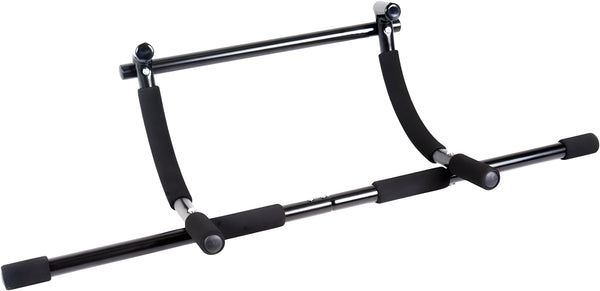Your Cart is Empty
April 15, 2023 4 min read
Pull up training is a great way to get in shape and build strength. This exercise can be done with a variety of different pieces of equipment, such as barbells, dumbbells, resistance bands, and even your own bodyweight. It’s an incredibly effective full-body workout that targets many muscle groups at once, including the back, shoulders, arms, and core.
Shop The Collection: Pull Up BarsThe pull up is a compound exercise, meaning that it requires multiple joints and muscles to move together in order to complete the movement. This offers a huge advantage over isolation exercises, which focus on one particular muscle group. When performed correctly, pull ups will not only target the muscles used for the actual lift, but also those that assist in stabilizing the body during the exercise.
 Shop The Gear: CAP Barbell Xtreme Doorway Pull Up Bar, $27.99 USD
Shop The Gear: CAP Barbell Xtreme Doorway Pull Up Bar, $27.99 USD
Pull up training has numerous benefits, and can be an effective part of any fitness routine. Here are some of the most notable advantages of pull up training:
In addition, pull up training can be done almost anywhere with minimal equipment. All you need is a pull up bar and enough room to move safely and comfortably. This makes it a great option for those who don't have access to a gym or are looking for a convenient way to stay in shape on the go.
Before attempting to do pull ups, it's important to make sure you have the proper form and technique. If done incorrectly, this exercise can cause injury. Here are some tips to ensure that you perform a safe and effective pull up:
There are a variety of different types of pull ups that can be done. This allows you to target different muscle groups and work on more challenging variations as your strength and skill improves. Here are some of the most common types of pull ups:
As with any new fitness routine, it's important to be aware of the most common mistakes that people make when performing pull ups. Here are some of the most common mistakes to avoid:
Pull up training is a great way to get in shape and build strength. It's an efficient full-body exercise that targets multiple muscle groups simultaneously. With the right form and technique, you can maximize the benefits of this exercise and avoid potential injury. There are a variety of different types of pull ups that can be done, allowing you to target different muscle groups and increase the challenge as your strength and skill improves. By avoiding common mistakes, you can ensure that you get the most out of your workout.
Shipping Protection gives you peace of mind while saving you time and money.
Shipping Protection provides coverage for eligible orders that are lost or damaged in transit, or stolen after delivery has been confirmed by the carrier. MAGMA Fitness, through its partners, administers the protection program and may receive compensation for these services. Coverage is subject to the terms, conditions, and exclusions outlined in our Shipping Protection Terms & Conditions.